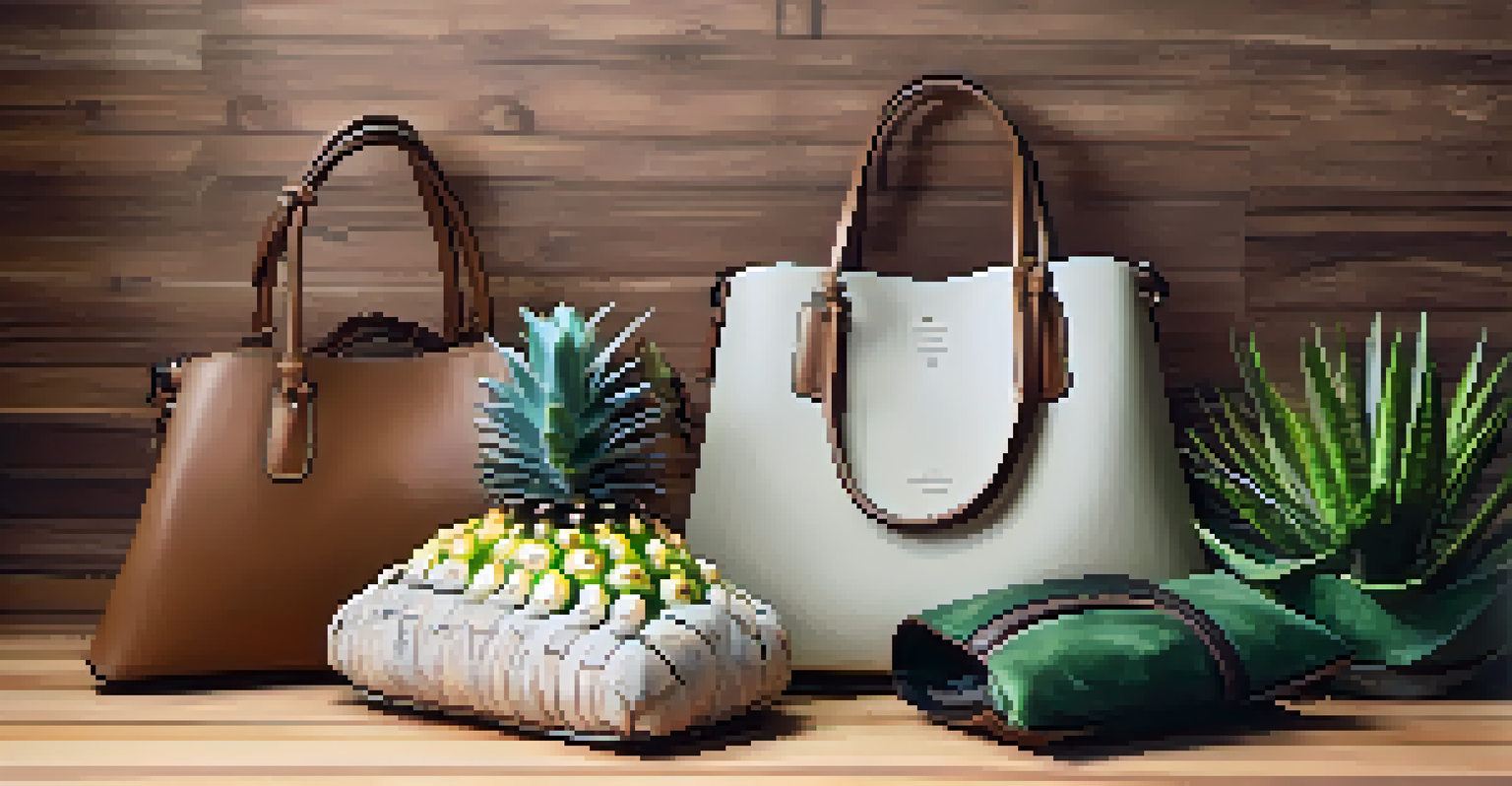Luxury Fashion and Sustainability: Icons Leading Change

The Intersection of Luxury Fashion and Sustainability
In recent years, the luxury fashion industry has begun to embrace sustainability, recognizing that it’s no longer just a trend, but a necessity. High-end brands are taking steps to reduce their environmental footprint, from sourcing eco-friendly materials to improving labor practices. This shift not only appeals to eco-conscious consumers but also sets a standard for the entire fashion industry.
Sustainability is no longer a nice-to-have; it's a must-have for businesses that want to thrive in the future.
Sustainability in luxury fashion means creating beautiful pieces that don’t come at the expense of the planet. Designers are now focusing on innovative techniques, like zero-waste pattern making and using organic fabrics, to create collections that are both luxurious and responsible. This transformation is vital for preserving the industry’s future and ensuring that fashion remains relevant in a changing world.
By integrating sustainability into their core values, luxury brands are proving that elegance and ethics can coexist. This new approach not only enhances their brand image but also attracts a growing demographic of consumers who prioritize sustainability in their purchasing decisions. As luxury fashion icons lead the charge, they inspire others to follow suit, creating a ripple effect throughout the industry.
Key Players in the Sustainable Fashion Movement
Several luxury fashion icons are at the forefront of the sustainability movement, using their influence to make a positive impact. Brands like Stella McCartney have been pioneers, advocating for cruelty-free fashion and the use of sustainable materials since the early 2000s. McCartney's commitment to environmental responsibility has not only shaped her brand but also inspired many others in the industry.

Another notable player is Gucci, which has launched initiatives like the Gucci Equilibrium program, focusing on environmental and social sustainability. By promoting transparency in their supply chain and committing to reducing their carbon footprint, Gucci is setting a benchmark for luxury brands. Their efforts show that luxury can be both glamorous and responsible, appealing to a new generation of consumers.
Luxury Meets Sustainability
High-end brands are embracing eco-friendly practices as a core part of their identity, appealing to consumers who prioritize ethical choices.
Chloé is also making waves with its commitment to sustainable practices, including the use of organic cotton and recycled materials. Their 'Chloé Cares' initiative emphasizes responsible sourcing and ethical production, proving that luxury fashion can be mindful of its impact on both the environment and society. These brands are not just selling clothing; they are leading a movement toward a more sustainable future.
Innovative Materials Shaping Luxury Fashion
One of the most exciting developments in sustainable luxury fashion is the use of innovative materials. Brands are experimenting with alternatives to traditional fabrics, such as vegan leather made from mushrooms or pineapple leaves. These materials not only reduce reliance on animal products but also minimize environmental impact, aligning luxury with sustainability.
Fashion is the armor to survive the reality of everyday life.
Recycled materials are also gaining popularity, with many luxury brands incorporating plastics and textiles collected from oceans and landfills into their designs. This creative reuse not only helps clean the planet but also tells a story that resonates with consumers. Imagine wearing a gorgeous handbag made from recycled ocean plastic—it's a conversation starter and a step toward a cleaner world.
As technology advances, we can expect even more innovation in materials. From bio-fabrication to 3D printing, the future of luxury fashion looks promising. These developments offer exciting possibilities for creating high-quality, sustainable pieces that appeal to the fashion-forward and environmentally conscious shopper.
The Role of Transparency in Luxury Fashion
Transparency has become a buzzword in luxury fashion, and for good reason. Consumers today want to know where their products come from and how they are made. Brands that embrace transparency gain trust and loyalty from their customers, which is vital in a market where ethical consumption is on the rise.
Luxury fashion icons are now providing detailed information about their supply chains, including sourcing practices and labor conditions. This level of transparency not only empowers consumers to make informed choices but also holds brands accountable for their practices. When a brand openly shares its sustainability journey, it inspires confidence and encourages others to follow suit.
Transparency Builds Trust
Luxury fashion brands are increasingly sharing detailed information about their supply chains, fostering consumer trust and loyalty.
Moreover, transparency can lead to innovation in the industry. As brands share their challenges and successes, they create a community of learning and growth. This collaborative spirit is essential for advancing sustainability efforts and ensuring that luxury fashion evolves in a responsible manner.
The Impact of Consumer Demand on Luxury Brands
Consumer demand plays a crucial role in shaping the future of luxury fashion and sustainability. As more shoppers prioritize eco-friendly and ethically produced items, brands are compelled to adapt. This shift in consumer behavior is a powerful driver of change, encouraging luxury fashion houses to rethink their approaches to production and marketing.
Luxury brands are increasingly aware that sustainability isn’t just a checkbox; it’s a crucial part of their brand identity. Consumers are willing to support brands that align with their values, and this has led to a rise in sustainable collections and initiatives. By listening to their audience, luxury brands are not only enhancing their reputation but also contributing to a healthier planet.
The message is clear: when consumers demand sustainability, brands must respond. This dynamic relationship fosters a culture of responsibility and innovation in the luxury fashion sector. Ultimately, the power lies in the hands of the consumer, driving brands to evolve and embrace sustainable practices.
Challenges Facing Sustainable Luxury Fashion
Despite the progress made in sustainable luxury fashion, several challenges still lie ahead. One major hurdle is the perception that sustainable products compromise quality and luxury. Many consumers still associate high-end fashion with exclusivity and opulence, making it essential for brands to demonstrate that sustainability doesn’t mean sacrificing elegance.
Another challenge is the complexity of supply chains in the luxury sector. Ensuring that every step of the production process adheres to sustainable practices requires significant investment and vigilance. Brands must navigate a web of suppliers, materials, and logistics, making it crucial to foster strong relationships with partners who share their commitment to sustainability.
Consumer Demand Drives Change
As shoppers increasingly seek sustainable products, luxury brands are compelled to adapt and innovate in their approaches to production.
Additionally, the luxury fashion market is often driven by trends, which can lead to overproduction and waste. To combat this, brands need to adopt a more mindful approach to collections, focusing on timeless designs rather than fast fashion. By shifting their mindset and operations, luxury brands can overcome these challenges and lead the way in sustainable fashion.
The Future of Luxury Fashion: A Sustainable Path Forward
Looking ahead, the future of luxury fashion hinges on sustainability. As more brands embrace eco-friendly practices, we can expect to see a significant shift in the industry. This change will not only redefine luxury but also promote a culture of responsibility and conscientious consumption among consumers.
The integration of technology will play a pivotal role in shaping sustainable luxury fashion. Innovations in materials, production methods, and supply chain transparency will enable brands to create beautiful, high-quality products while minimizing their environmental impact. This fusion of fashion and technology will pave the way for a new era of luxury.

Ultimately, the icons of luxury fashion leading this change are not just setting trends; they are creating a legacy. By prioritizing sustainability, they are ensuring that future generations can enjoy the beauty of fashion without compromising the health of our planet. As consumers, we have the power to support this movement and demand a fashion industry that values both elegance and ethics.